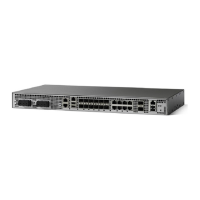You can determine the MRU for the LSP at each hop through the use of the show forwarding detail command:
Device# show mpls forwarding 10.131.159.252 detail
Local Outgoing Prefix Bytes tag Outgoing Next Hop
tag tag or VC or Tunnel Id switched interface
22 19 10.131.159.252/32 0 Tu1 point2point
MAC/Encaps=14/22, MRU=1496, Tag Stack{22 19}, via Et0/0
AABBCC009700AABBCC0098008847 0001600000013000
No output feature configured
To determine the maximum sized echo request that will fit on the LSP, you can find the IP MTU by using the
show interface type number command.
Device# show interface e0/0
FastEthernet0/0/0 is up, line protocol is up
Hardware is Lance, address is aabb.cc00.9800 (bia aabb.cc00.9800)
Internet address is 10.131.191.230/30
MTU 1500 bytes, BW 10000 Kbit, DLY 1000 usec, rely 255/255, load ½55
Encapsulation ARPA, loopback not set
Keepalive set (10 sec)
ARP type: ARPA, ARP Timeout 04:00:00
Last input 00:00:01, output 00:00:01, output hang never
Last clearing of "show interface" counters never
Input queue: 0/75/0/0 (size/max/drops/flushes); Total output drops: 0
Queueing strategy: fifo
Output queue: 0/40 (size/max)
5 minute input rate 0 bits/sec, 0 packets/sec
5 minute output rate 0 bits/sec, 0 packets/sec
377795 packets input, 33969220 bytes, 0 no buffer
Received 231137 broadcasts, 0 runts, 0 giants, 0 throttles
0 input errors, 0 CRC, 0 frame, 0 overrun, 0 ignored
0 input packets with dribble condition detected
441772 packets output, 40401350 bytes, 0 underruns
0 output errors, 0 collisions, 10 interface resets
0 babbles, 0 late collision, 0 deferred
0 lost carrier, 0 no carrier
0 output buffer failures, 0 output buffers swapped out
The IP MTU in the show interface type number example is 1500 bytes. Subtract the number of bytes
corresponding to the label stack from the MTU number. From the output of the show mpls forwarding
command, the Tag stack consists of one label (21). Therefore, the largest MPLS echo request packet that can
be sent in the LSP, shown in the figure above, is 1500 - (2 x 4) = 1492.
You can validate this by using the following ping mpls command:
Device# ping mpls ipv4 10.131.159.252/32 sweep 1492 1500 1 repeat 1
Sending 1, [1492..1500]-byte MPLS Echos to 10.131.159.252/32,
timeout is 2 seconds, send interval is 0 msec:
Codes: '!' - success, 'Q' - request not transmitted,
'.' - timeout, 'U' - unreachable,
'R' - downstream router but not target
Type escape sequence to abort.
!QQQQQQQQ
Success rate is 11 percent (1/9), round-trip min/avg/max = 40/40/40 ms
In this command, only packets of 1492 bytes are sent successfully, as indicated by the exclamation point (!).
Packets of byte sizes 1493 to 1500 are source-quenched, as indicated by the Q.
You can pad an MPLS echo request so that a payload of a given size can be tested. The pad TLV is useful
when you use the MPLS echo request to discover the MTU supportable by an LSP. MTU discovery is extremely
important for applications like AToM that contain non-IP payloads that cannot be fragmented.
MPLS Basic Configuration Guide, Cisco IOS XE Everest 16.5.1 (Cisco ASR 900 Series)
84
MPLS LSP Ping, Traceroute, and AToM VCCV
MTU Discovery in an LSP

